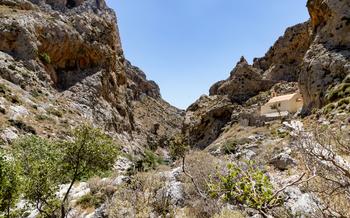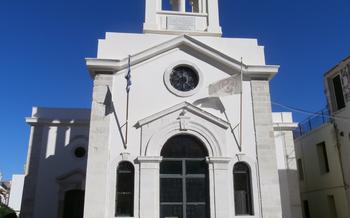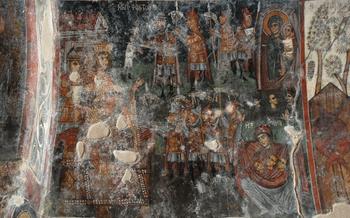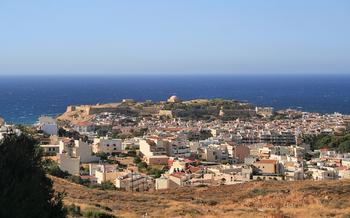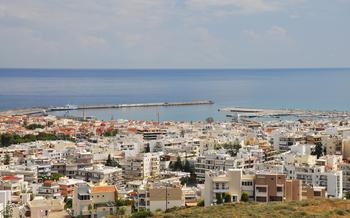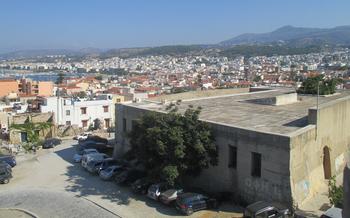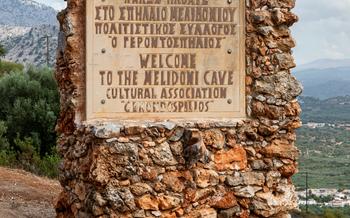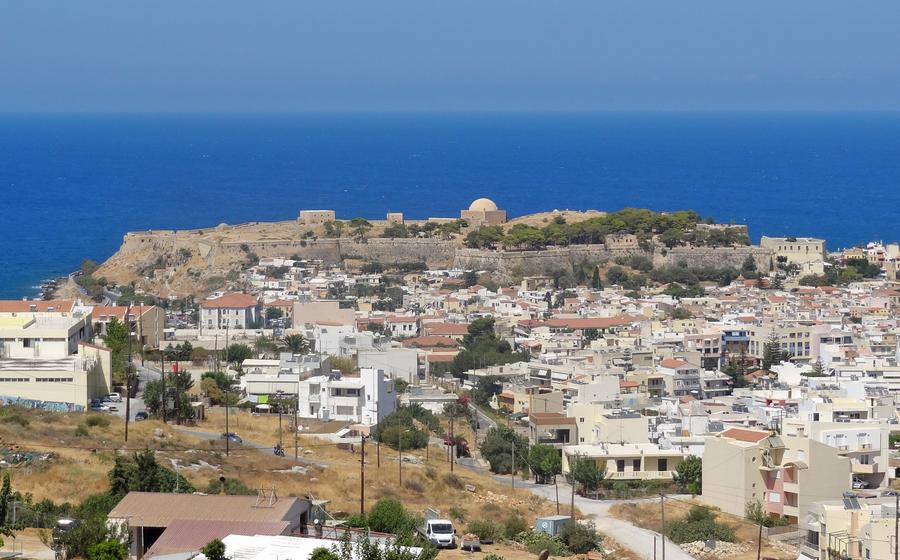
St. Anthony Gorge
- St. Anthony Gorge: An Overview
- The Historical Significance of the Gorge
- The Religious Significance of the Gorge
- The Natural Beauty of the Gorge
- The Tourism Potential of the Gorge
- Insider Tips for Visitors
- Exploring the Gorge on Foot
- Discovering the Chapels and Monasteries
- Experiencing the Annual Pilgrimage
- Capturing the Beauty of the Gorge
- St. Anthony Gorge: A Haven for Nature Enthusiasts
- Promoting Sustainable Tourism
- Preserving the Gorge's Cultural Heritage
- Respecting the Local Culture:
- Insider Tip: Hidden Gems of the Gorge
St. Anthony Gorge: An Overview
In the heart of Crete, Greece, lies a breathtaking natural wonder: the St. Anthony Gorge. With its profound historical and religious significance, stunning natural beauty, and immense tourism potential, the gorge offers an unforgettable experience for every visitor. Nestled in the picturesque region of Rethymno, the gorge beckons nature enthusiasts, history buffs, and pilgrims alike to explore its hidden treasures. Let's delve into the allure of this captivating gorge and discover why it's a must-visit destination in Crete.
Geographical Location and Natural Beauty:
The St. Anthony Gorge is a natural masterpiece carved by the ceaseless flow of the Agios Antonios River. It's located around 30 kilometers southeast of Rethymno town, easily accessible by car or organized tour. As you approach the gorge, the towering cliffs, lush vegetation, and the meandering river create a mesmerizing panorama that sets the tone for your adventure.
Tourism Potential and Visitor Experiences:
The St. Anthony Gorge has emerged as a prominent destination for nature lovers and adventure seekers. Its diverse landscape offers a multitude of activities, from hiking and trekking on well-marked trails to birdwatching and wildlife spotting amidst the rich ecosystem. Visitors can immerse themselves in the gorge's pristine beauty, marvel at its geological wonders, and capture breathtaking photographs of its unique rock formations.
How to Get There from Rethymno:
Reaching the St. Anthony Gorge from Rethymno is straightforward. You can either drive your own vehicle or take advantage of the organized bus tours that depart from the city. The drive takes approximately 45 minutes, offering panoramic views of the Cretan countryside along the way. Once you arrive at the gorge's entrance, you'll find ample parking space and friendly locals ready to guide you to the start of your adventure.
The Historical Significance of the Gorge
The St. Anthony Gorge holds profound historical significance, deeply intertwined with the life of St. Anthony the Great, a revered figure in Christianity. According to legend, St. Anthony sought refuge within the gorge's secluded caves in the 3rd century AD, fleeing the distractions of worldly life to pursue a life of solitude and prayer. His presence transformed the gorge into a sacred site, attracting followers and disciples who sought his guidance and teachings.
Over time, the gorge became a refuge for persecuted Christians, especially during periods of religious strife. Its remote location and natural barriers provided a safe haven for those seeking solace and protection from religious persecution. The gorge's caves and hidden chambers served as sanctuaries, where Christians could congregate and practice their faith freely.
Legends and folklore abound in the St. Anthony Gorge, passed down through generations of locals. Tales of miracles and divine interventions attributed to St. Anthony are deeply embedded in the region's oral tradition. These stories have shaped the gorge's reputation as a place of spiritual significance, attracting pilgrims and visitors from far and wide who come to experience its sacred atmosphere.
The Religious Significance of the Gorge
The religious significance of the St. Anthony Gorge is undeniable. Within its depths, visitors will find several chapels and monasteries, each steeped in history and spirituality. The most prominent among them is the Monastery of St. Anthony, built in the 14th century and dedicated to the gorge's patron saint. This monastery, nestled amidst towering cliffs, is a testament to the gorge's enduring religious importance.
Every year, on January 17th, the gorge becomes a focal point of religious devotion during the annual pilgrimage to honor St. Anthony. Thousands of pilgrims from across Crete and beyond flock to the gorge to participate in this sacred event. The pilgrimage is a vibrant display of faith, featuring traditional Cretan music, dancing, and the carrying of the saint's icon in a solemn procession.
The spiritual atmosphere of the gorge is palpable, inviting visitors to contemplate and connect with their inner selves. Whether seeking solace, guidance, or a deeper understanding of their faith, many find the gorge to be a sanctuary for reflection and spiritual growth.
The Natural Beauty of the Gorge
The St. Anthony Gorge is a natural paradise, home to a diverse range of flora and fauna. The gorge's unique microclimate creates an ideal habitat for various plant species, including rare and endemic flowers. Visitors can spot colorful orchids, lilies, and anemones blooming along the trails. The gorge is also home to several animal species, including birds of prey, reptiles, and small mammals. Lucky visitors might even catch a glimpse of the rare Cretan wild goat, the Kri-Kri, roaming the rocky slopes of the gorge.
The stunning rock formations and geological features of the gorge are a sight to behold. The towering cliffs, carved by centuries of erosion, create a dramatic and awe-inspiring landscape. Visitors can admire the intricate patterns and colors of the rocks, formed by the interplay of different minerals and geological processes. The gorge also features several caves and tunnels, some of which are accessible to visitors and offer a unique perspective on the gorge's natural wonders.
The breathtaking views of the surrounding landscape from the gorge are simply unforgettable. Visitors can enjoy panoramic vistas of the lush green valleys, the sparkling Mediterranean Sea, and the majestic White Mountains in the distance. The gorge's unique vantage point offers a bird's-eye view of the region's natural beauty and allows visitors to appreciate the diverse landscapes of Crete.
The St. Anthony Gorge is a place of exceptional natural beauty that offers visitors a chance to immerse themselves in the wonders of the Mediterranean ecosystem. Its diverse flora and fauna, stunning rock formations, and breathtaking views make it a must-visit destination for nature enthusiasts and anyone seeking a truly awe-inspiring experience.
The Tourism Potential of the Gorge
The St. Anthony Gorge is a treasure trove of natural beauty and historical significance, making it a popular destination for tourists from around the world. The gorge offers an array of activities for visitors, including hiking, trekking, nature exploration, photography, birdwatching, and wildlife spotting. The stunning scenery, unique microclimate, and rich biodiversity of the gorge create an ideal environment for outdoor enthusiasts and nature lovers.
The gorge has the potential to become a sustainable tourism destination, attracting visitors who are conscious of minimizing their impact on the environment. Sustainable tourism practices, such as using eco-friendly transportation, supporting local businesses, and respecting the natural and cultural heritage of the gorge, can be implemented to ensure its long-term preservation.
Moreover, the gorge plays a vital role in promoting the region's cultural heritage. By visiting the gorge, tourists can learn about the history of St. Anthony, the religious significance of the gorge, and the traditional customs and practices of the local communities. This exchange of cultural experiences fosters a sense of understanding and appreciation among visitors and locals alike.
Insider Tips for Visitors
To make the most of your visit to the St. Anthony Gorge, here are some insider tips:
-
Timing is Everything: Aim to visit the gorge during the shoulder seasons (spring and autumn) for pleasant weather and fewer crowds. In summer, the heat can be intense, and in winter, some trails may be inaccessible due to snow or rain.
-
Dress Appropriately: Wear comfortable hiking shoes or sturdy sneakers, as the terrain can be uneven and rocky. Dress in layers to adapt to changing temperatures, and don't forget a hat and sunscreen.
-
Guided Tours: Consider joining a guided tour for a deeper understanding of the gorge's history, nature, and religious significance. Tours typically include transportation from Rethymno, knowledgeable guides, and insights into local traditions.
-
Safety First: Always stay on marked trails and avoid venturing off into unmarked areas. Be aware of your surroundings, and if you're hiking alone, let someone know your itinerary and expected return time.
Exploring the Gorge on Foot
The St. Anthony Gorge offers a range of hiking trails that cater to different levels of experience and fitness. Whether you're a seasoned hiker seeking a challenging adventure or a nature enthusiast looking for a leisurely stroll, there's a trail that suits your needs.
The most popular trail is the one that leads to the main chapel of St. Anthony, located at the heart of the gorge. This relatively easy trail takes about an hour to complete, passing through lush vegetation and offering stunning views along the way.
For those seeking a more challenging experience, the trail that leads to the upper gorge is a rewarding option. This trail requires some scrambling and climbing, but it offers breathtaking panoramic views of the surrounding landscape.
Whichever trail you choose, be sure to follow the marked paths and observe safety guidelines. The gorge's terrain can be rugged in places, and it's essential to avoid venturing off-trail or taking unnecessary risks.
Here are some tips for navigating the gorge's trails safely and responsibly:
- Wear sturdy hiking shoes or boots with good ankle support.
- Bring plenty of water, especially during hot weather.
- Be prepared for changes in weather conditions and carry appropriate clothing.
- Stay on marked trails to avoid getting lost or damaging the environment.
- Be aware of your surroundings and watch out for potential hazards such as loose rocks or slippery surfaces.
- Respect wildlife and observe them from a distance without disturbing them.
- Leave no trace by packing out all your trash and avoiding littering.
Discovering the Chapels and Monasteries
Embedded within the embrace of the St. Anthony Gorge, an array of chapels and monasteries stand in reverence, each narrating its unique tale of faith and devotion. The Monastery of St. Anthony, nestled amidst a serene landscape, holds a prominent place, its history intertwined with the gorge's spiritual essence. Erected in the 17th century, the monastery served as a sanctuary for monks seeking refuge and communion with the divine. Its architecture, influenced by Byzantine and Venetian styles, reflects the rich cultural heritage of the region.
As you venture further into the gorge, you will encounter various chapels, each dedicated to a different saint. The Chapel of the Holy Cross, perched on a rocky outcrop, offers breathtaking views of the surrounding terrain. The Chapel of the Panagia, adorned with intricate frescoes, invites you to contemplate the sacredness of the gorge. These chapels, though modest in size, exude an aura of spirituality that envelops visitors in a sense of peace and tranquility.
Exploring these religious sites is not merely a historical pursuit; it is an opportunity to immerse yourself in the local religious traditions and customs. Engage with the friendly monks and nuns who reside in the monasteries, and they will gladly share insights into their way of life and the significance of the gorge in their faith. Remember to observe proper etiquette and customs when visiting these sacred spaces, showing respect for the religious practices and beliefs of the local community.
Experiencing the Annual Pilgrimage
The annual pilgrimage to the St. Anthony Gorge is a unique and moving experience that attracts thousands of pilgrims and visitors each year. Held on June 13th, the pilgrimage commemorates the feast day of St. Anthony, the patron saint of the gorge. The festivities begin with a procession of religious icons and relics carried by local priests and dignitaries, followed by a mass held at the main chapel within the gorge. Pilgrims and visitors alike participate in the religious rituals, lighting candles, offering prayers, and seeking blessings. The pilgrimage also features traditional Cretan music, dancing, and food, creating a festive atmosphere that celebrates the region's cultural and religious heritage.
For those interested in experiencing the pilgrimage, it is advisable to arrive early to secure a good spot and witness the procession. It is also important to dress modestly and respectfully, as the pilgrimage is a sacred event for local communities. Visitors should also be prepared for crowds and potential delays, as the gorge can become quite busy during the pilgrimage. Participating in the pilgrimage is a wonderful opportunity to immerse oneself in the local culture, witness traditional Cretan customs, and gain a deeper understanding of the region's religious traditions.
Capturing the Beauty of the Gorge
The St. Anthony Gorge is a photographer's paradise, offering an array of stunning vistas and unique lighting conditions. Whether you're an amateur enthusiast or an experienced professional, the gorge provides ample opportunities to capture the region's natural beauty.
One of the best spots for photography is the gorge's entrance, where the towering cliffs and lush vegetation create a dramatic backdrop. As you venture deeper into the gorge, keep an eye out for picturesque pools, waterfalls, and rock formations that seem to defy gravity.
To capture the gorge's unique light, plan your visit during the golden hours of sunrise and sunset. The warm hues of the morning and evening sun illuminate the gorge's walls, casting long shadows that add depth and texture to your shots. Experiment with different angles and perspectives to create dynamic compositions that showcase the gorge's grandeur.
Wildlife enthusiasts can also find ample opportunities to photograph rare and endangered species within the gorge. With a keen eye and a telephoto lens, you might capture a glimpse of a soaring eagle, a shy mountain goat, or a colorful lizard basking in the sun.
Remember to respect the privacy of other visitors and the tranquility of the gorge. Avoid using flash photography near religious sites or when photographing wildlife. Always follow the designated trails and avoid venturing off-path to minimize your impact on the environment.
St. Anthony Gorge: A Haven for Nature Enthusiasts
The St. Anthony Gorge is a sanctuary for an array of flora and fauna, providing a haven for nature enthusiasts. The gorge's diverse ecosystem supports a variety of plant species, including aromatic herbs, wildflowers, and ancient olive trees. Birdwatchers will delight in the diverse avifauna, with species such as the majestic golden eagle, the agile peregrine falcon, and the colorful hoopoe soaring overhead. The gorge is also home to various reptiles, amphibians, and mammals, including the nimble Cretan wild goat, the elusive Cretan badger, and the rare Cretan spiny mouse.
Visitors can immerse themselves in the gorge's natural wonders by embarking on a guided nature walk or venturing on their own along the well-marked trails. These trails wind through the gorge, offering opportunities for wildlife spotting, birdwatching, and plant identification. It is essential to respect and protect the gorge's delicate ecosystem by staying on designated trails, avoiding disturbing wildlife, and refraining from collecting plants or animals.
The St. Anthony Gorge is a treasure trove of biodiversity, offering visitors a chance to connect with nature and appreciate the region's rich ecological heritage. Whether you are an experienced naturalist or simply seeking a tranquil escape, the gorge promises an unforgettable encounter with the wonders of the natural world.
Promoting Sustainable Tourism
St. Anthony Gorge is an environmentally sensitive area, and promoting sustainable tourism is crucial to preserving its natural beauty and cultural heritage for future generations. Sustainable tourism practices aim to minimize negative impacts on the environment and local communities, while maximizing social and economic benefits.
As a visitor, you can contribute to sustainable tourism by:
-
Choosing local tour operators: Opt for local tour operators that prioritize sustainable practices, such as using electric vehicles, supporting local businesses, and minimizing waste.
-
Respecting the natural environment: Stay on marked trails, avoid disturbing wildlife, and dispose of waste responsibly.
-
Supporting local businesses: Buy souvenirs and products from local artisans and businesses to support the local economy.
-
Promoting responsible behavior: Encourage fellow visitors to respect the environment and local culture, and report any inappropriate behavior to authorities.
By embracing sustainable tourism practices, you can contribute to the preservation of St. Anthony Gorge's unique ecosystem and cultural heritage, while ensuring that future generations can enjoy this natural wonder responsibly.
Preserving the Gorge's Cultural Heritage
The St. Anthony Gorge is not only a natural wonder but also a treasure trove of cultural heritage. The gorge has been inhabited for centuries, and its history is intertwined with the history of Crete. The gorge is home to several historical and religious sites, including chapels, monasteries, and hermitages. These sites are a testament to the region's rich religious traditions and offer a glimpse into the lives of the people who have lived in the gorge over the centuries.
Efforts are underway to protect and restore the gorge's historical and religious sites. Local communities are playing a vital role in preserving the gorge's traditions and customs. Visitors can contribute to the preservation of the gorge's cultural heritage by respecting the local culture, visiting the gorge's historical and religious sites, and supporting local businesses and products.
By working together, we can ensure that the St. Anthony Gorge remains a place of natural beauty and cultural significance for generations to come.
Respecting the Local Culture:
When exploring the St. Anthony Gorge, it is essential to be mindful of the local culture and traditions. The people of Crete are known for their warm hospitality, but they also value respect and understanding from visitors. Here are a few tips for interacting respectfully with the locals:
- Greet people with a friendly "kalimera" (good morning) or "kalispera" (good evening).
- Dress modestly, especially when visiting religious sites.
- Be respectful when taking photographs of local people, especially if they are in traditional dress. It is always polite to ask for permission before taking someone's photo.
- When visiting churches or monasteries, observe the local customs and etiquette. For example, women should cover their shoulders and knees, and men should remove their hats.
- Learn a few basic Greek phrases, such as "thank you" (efharisto) and "please" (parakalo). This shows that you are making an effort to engage with the local culture.
- Support local businesses by purchasing souvenirs and products from local artisans. This helps to preserve the region's traditional crafts and livelihoods.
By respecting the local culture, you can help to ensure that the St. Anthony Gorge remains a welcoming and enjoyable place for both visitors and locals alike.
Insider Tip: Hidden Gems of the Gorge
Beyond the well-known trails and landmarks, the St. Anthony Gorge holds secret treasures waiting to be discovered by adventurous explorers. These hidden gems offer unique experiences and perspectives that unveil the gorge's lesser-known wonders.
One such hidden gem is a secluded waterfall tucked away amidst the lush vegetation. The sound of cascading water fills the air, creating a tranquil oasis perfect for a refreshing break. Follow a narrow path that leads to a natural pool beneath the falls, where you can take a dip and enjoy the invigorating spray.
Another hidden gem is a hidden viewpoint that offers breathtaking panoramas of the gorge and the surrounding landscape. Ascend a steep but rewarding trail to reach this viewpoint, where you can witness the gorge's stunning beauty from a unique perspective. Capture panoramic shots of the rugged cliffs, dense forests, and distant peaks that stretch out before you.
These hidden gems remind us that the St. Anthony Gorge is a place of endless exploration and discovery. Embrace the spirit of adventure and seek out these lesser-known treasures. Remember to respect the environment, stay on designated trails, and leave no trace behind so that future visitors can also enjoy these hidden wonders.

